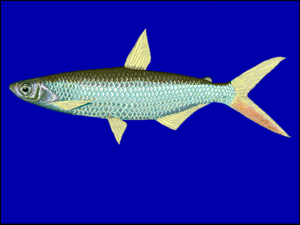Pebbly fish facts for kids
Alestes baremoze, also known as the pebbly fish or silversides, is a type of fish found in the freshwater rivers and lakes of northern and western Africa. This fish is important because people catch it for food.
Quick facts for kids Pebbly fish |
|
|---|---|
 |
|
| Conservation status | |
| Scientific classification | |
| Synonyms | |
|
Contents
What Does the Alestes Baremoze Look Like?
The Alestes baremoze is a shiny silver fish. Its back is bluish-grey, and its belly is white. Its fins are grey, but the bottom part of its tail fin has an orange color.
This fish can grow up to 43 centimeters (about 17 inches) long. It can weigh as much as 500 grams (about 1 pound). However, it can start having babies when it is about 20 centimeters long. This fish is part of the Characiformes order, the Alestidae family, and the Alestes genus. Scientists have studied its body and what it eats. They found that it can eat many different kinds of food. This means it is an omnivore, eating both plants and animals.
Where Does the Alestes Baremoze Live?
This fish lives in many parts of Africa. In eastern Africa, you can find it in Lake Albert, the White Nile river, and Lake Turkana.
In northern Africa, it used to live all along the River Nile in Egypt. This included the Nile Delta lakes and other parts of the lower Nile. But after the Aswan High Dam was built, it now only lives in the upper parts of the Nile. You won't find it in northern Egypt anymore.
The Alestes baremoze also lives in the Bahr el Ghazal River and Bahr el Jebel systems. It is found in the White and Blue Niles in Sudan, reaching north to Lake Nasser. It has also been seen in Ethiopia's Baro River. In West Africa, it is common in the river basins of Chad, Niger, Volta, Comoé, Bandama, Sassandra, Geba, Gambia, and Senegal.
How Does the Alestes Baremoze Live?
The Alestes baremoze is mostly active during the day. It usually stays near the shores of lakes. However, it can also move between rivers and lakes. It also swims near the bottom of the water, but not always on the very bottom.
This fish is not picky about its food. It can change what it eats depending on what is available. It might eat tiny water animals called zooplankton. It can also eat small creatures that live on the bottom, known as zoobenthos. Sometimes it eats dead plant and animal matter (detritus) or larger water plants called macrophytes. It changes its diet when there are fewer tiny water animals to eat.
Reproduction and Life Cycle
When it's time to have babies, both male and female fish gather in calm bays along lake shores. Adult fish that are not breeding will swim upriver from lakes when the rivers are full of water. There, they gather in large groups called shoals and feed.
In Lake Chad, the fish lay their eggs in the late afternoon and evening, usually between 4:30 PM and 8:00 PM. A female fish lays all her eggs at once. The total weight of her eggs can be about 15% of her own body weight. When laying eggs, the female fish spread out and do not stay in groups.
Why Is This Fish Important to People?
The Alestes baremoze is known as Angara in Uganda. It is a very popular and valuable fish in Northern Uganda, South Sudan, Sudan, and the Democratic Republic of Congo. Many people, especially in the West Nile region, really like its taste and texture.
Salting is a common way to prepare this fish. It helps the fish last longer and also creates a product that many consumers enjoy. Studies show that the fish has good amounts of protein, about 17-18%. It also contains important minerals like zinc and potassium.
Fishing for Alestes Baremoze
People catch Alestes baremoze in the Nile River, especially in Egypt, and often salt it. On Lake Chad, fishermen use seine nets (long nets that hang in the water) and gill nets (nets that catch fish by their gills) to catch them during different times of the year.


